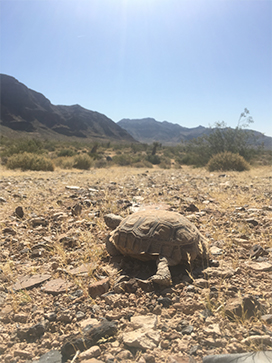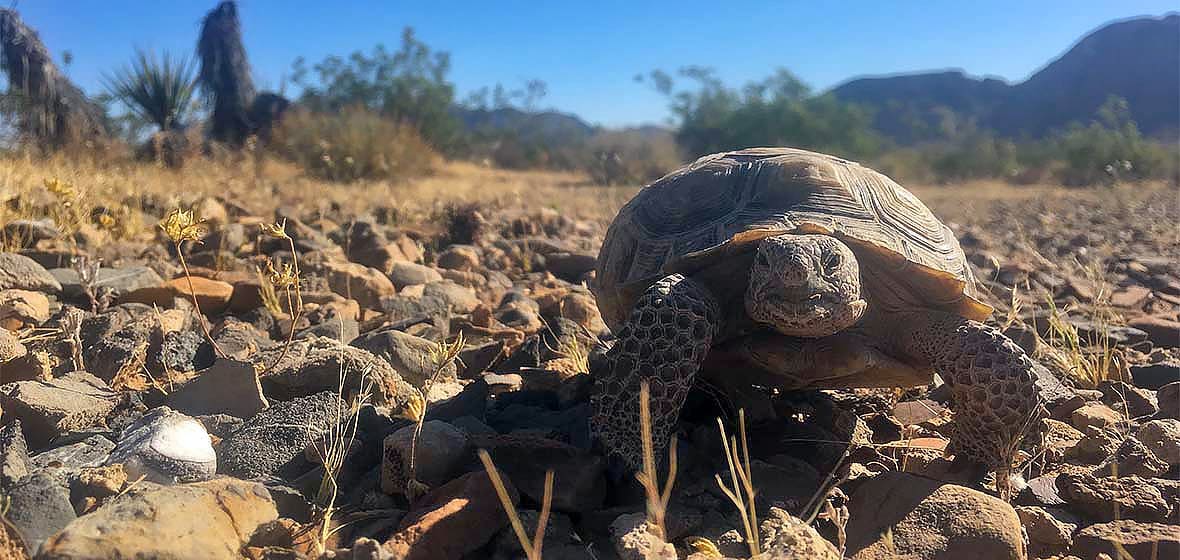A team of scientists and students are tracking desert tortoises across the desert with tools like radios and fluorescent powder to record data on the climate resistance of the tortoise's reproductive ecology. The novel approach to studying the effects of climate change on the Mojave Desert Tortoise is underway at the University of Nevada, Reno.
The four-year project headed by Kevin Shoemaker, an assistant professor in the Department Natural Resources and Environmental Science, is being conducted in the Nevadan desert in order to observe the effects of climate change on the federally-protected tortoise and to provide the Department of Defense with management strategies to support the tortoise populations.
"We hope to provide a clearer picture into what can be done to keep the tortoise population thriving," Shoemaker said. "Since little information is known about the effects of climate change on this species, the research may provide tools and guidance for more effective management of the tortoises."

Juvenile tortoise at Hidden Valley, Clark County, NV. Photo by M. Walden.
The project was able to become a long-term, four-year funded project through an $893,000 grant from the Department of Defense program called the Strategic Environmental Research and Development Program. The Department of Defense is required by the Endangered Species Act to protect threatened species that occur on their land. This grant also supports research of the Gopher Tortoise in the southeastern United States.
The grant is used to support field technicians as well as funding for the equipment to track the tortoises. The technicians place a radio transmitter on top of the animal so they can follow them during nesting time. Another tool, fluorescent powder, also allows the technicians to trace tortoise movement and their nest location by following a trail of powder that is applied to the plastron (the "belly" shell). Ultrasound units are also utilized to identify whether the tortoises are ready to lay eggs.
Shoemaker was also able to collaborate with professors from different University departments to aid in the research. Assistant Professor of Geography Ken Nussear and Professor of Natural Resources and Environmental Sciences Marjorie Matocq are among the professors he is working with, as well as multiple doctoral students. Nussear will be assisting the team in using Unmanned Aerial Vehicles (UAVs) to map the thermal environment experienced by the tortoises, and Matocq will assist in performing genomic analysis to confirm the source locations of translocated animals.
He and his team are investigating specifically the effects of climate change on the desert tortoise because it is an under-researched component into the threats to the animal.
"The sex of the desert tortoise's offspring is dependent on the temperature the eggs are incubated under," Shoemaker said. "So one concern of climate change on the desert tortoise population is the possible consequences on sex ratios and how big or small of an issue it actually is."
Shoemaker is also studying how flexible the tortoises' behaviors are, and if they can adjust to rapidly changing climate.
The research team is gathering samples from across the range to collect data from multiple climates, as well as studying tortoises that were translocated, and comparing their vital rates to those of resident tortoises that had been in the environment long-term.
"Hopefully, for the tortoises' sake, data shows that the tortoises are able to thrive in a variety of climate conditions," said Shoemaker. "We hope to discover that the tortoises have the phenotypic plasticity to withstand different environments so that we can focus on other threats posed to the tortoises."











